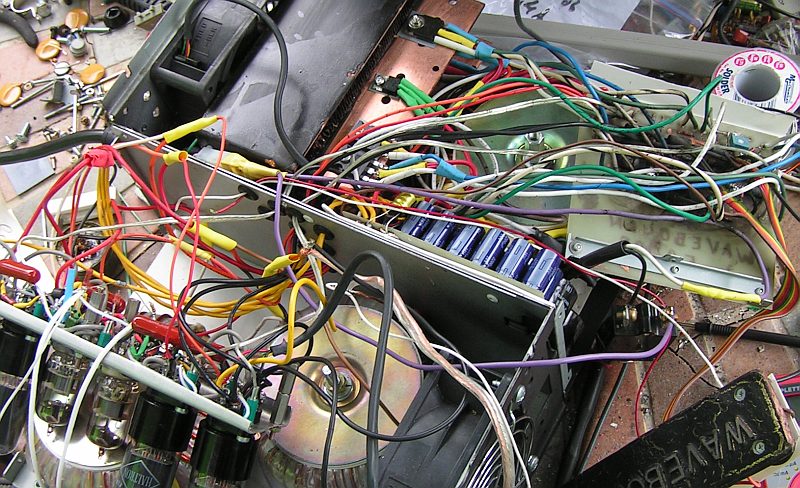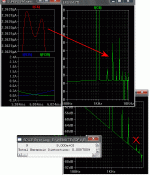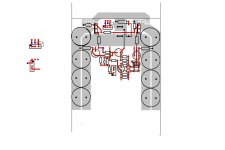So it is the doppler effect and I knew how that works 35 years ago. First this has nothig to do with doppler effect. It refers to the relative velocity of the source compared to the observer and the pitch change caused. Not the vibrational movement. It does effect speakers reproducing more than one frequency. Hows this relate to power amps?
Not necessarily. The loudness increase only if the displacement increases, faster they move the higher the frequency, the bigger they are or the further they move the louder they are.(I guess to move further it has to move faster, is that what you mean?) And as far as harmonics this is also generalizng louder dosnt always mean more harmonics.
If the playback adds to the harmonics that are already there you will hear the difference, the sound will be brighter.
Aside: (what moves on a flute? )
Again you skirt the topic.
Can we get back to power amps?
The louder they sound, the faster is the movement, the higher is an energy of higher order harmonics in respect to the level of the fundamental frequency.
Not necessarily. The loudness increase only if the displacement increases, faster they move the higher the frequency, the bigger they are or the further they move the louder they are.(I guess to move further it has to move faster, is that what you mean?) And as far as harmonics this is also generalizng louder dosnt always mean more harmonics.
If the playback adds to the harmonics that are already there you will hear the difference, the sound will be brighter.
Aside: (what moves on a flute? )
Again you skirt the topic.
Can we get back to power amps?
By CBDB-but Im trying to find real answers that can be translated into a real better amp.
I do like class A amps ( talked BS last night) and the 200 watt stealth provided an excellent benchmark to base my opinions on.
what caught my ears was Obvious, not subjective . The stealth sounded better than any of my creations or any of my japanese Hi-fi , Ii was jealous !!
 Upon simulating and testing the genesis , I found that it lacked ANY high order distortion components (mostly H2), while my creations (class B) all had H5/7. Even at 110db below the fundamental this DID affect the sound. I wanted to get my symasym to match the genesis in sound , so I isolated the source of these distortions. As these are inherant to the EF class b stage itself , I explored how to at least minimize this with nested feedback to cancel out the Xover artifact and just the right charge "suckout" cap,This was very dependant on OP device Cob. In the end , I did get a NOTICEABLE improvement ,with the class B sounding right on par with the stealth at full Bias. (attached is the FFT of the possible cause). The B , because of it's greater efficiency ,was more dynamic at high volumes and ran MUCH cooler (with the stealth I had to run a fan or use the A/C , which detracts from "audiophilia" ) At low volumes , quality was equal , medium -the class A had just a hair more detail in the sound stage , but at obscene levels the class B had the ultimate authority (headroom).
Upon simulating and testing the genesis , I found that it lacked ANY high order distortion components (mostly H2), while my creations (class B) all had H5/7. Even at 110db below the fundamental this DID affect the sound. I wanted to get my symasym to match the genesis in sound , so I isolated the source of these distortions. As these are inherant to the EF class b stage itself , I explored how to at least minimize this with nested feedback to cancel out the Xover artifact and just the right charge "suckout" cap,This was very dependant on OP device Cob. In the end , I did get a NOTICEABLE improvement ,with the class B sounding right on par with the stealth at full Bias. (attached is the FFT of the possible cause). The B , because of it's greater efficiency ,was more dynamic at high volumes and ran MUCH cooler (with the stealth I had to run a fan or use the A/C , which detracts from "audiophilia" ) At low volumes , quality was equal , medium -the class A had just a hair more detail in the sound stage , but at obscene levels the class B had the ultimate authority (headroom). OS
Attachments
cbdb said:Aside: (what moves on a flute? )
The same: why horn speakers so nice play Louis Armstrong?
Again you skirt the topic.
If I have a different opinion on the topic, it does not mean I skirt it.
Can we get back to power amps?
It is about power amps, as well. Do you really believe that audiophiles love distortions of single ended power amps because they add specific distortions? Or because they don't add distortions that add some other amps considered to be more clean?
john curl said:Need the loan of a Parasound?
Do you mean I can borrow one from you? I would love to. But it is not a commercial concert, though... I've found the solution to my problem, but it will involve a PCB redesign, unfortunately...
Cant say yet, but I hope this will be a nice amp
Still working on layout changes, and supply bridge is still missing
And still need to find the exact size of components, which seems a bit tricky
Schematic is Dx, the simplest of Dx designed by Carlos
Even small changes sometimes means I have to start all over again
But I cant help but continue to change and keep changing, until I cant find any more to change
Sometimes it seems better, other times it dont, and its backwards again
A lot of work as I use just a simple paint, and better software might have been nice
And I sure could use just a bit more knowledge about electronics
But its still great fun
Still working on layout changes, and supply bridge is still missing
And still need to find the exact size of components, which seems a bit tricky
Schematic is Dx, the simplest of Dx designed by Carlos
Even small changes sometimes means I have to start all over again
But I cant help but continue to change and keep changing, until I cant find any more to change
Sometimes it seems better, other times it dont, and its backwards again
A lot of work as I use just a simple paint, and better software might have been nice
And I sure could use just a bit more knowledge about electronics
But its still great fun
Attachments
ostripper said:
I explored how to at least minimize this with nested feedback to cancel out the Xover artifact and just the right charge "suckout" cap,This was very dependant on OP device Cob.
Can you post up the schematic with components values of your nested feedback amp? I had tried building a nested feedback amp based on the NE5534 and LT1028 but was never able to make it stable.
I'm confused again. Where did I say that I like even order distortion? Or any added distortion? However, sometimes we worry too much about the distortion measurement and not as much attention to the sound from the device. I am truly perplexed why single ended amps of the FINEST DESIGN sound so good. Many here are mistaken that I like added 2'nd harmonic. I have designed FULLY BALANCED DESIGNS, virtually exclusively, for the last 41 years.
Yes, Wavebourn, I have spare JC-1 power amps just sitting in my living room unattached to anything. They should work, if you need one or two channels. It is professional courtesy that I am offering. I understand your situation. Nelson Pass or Demian would probably do the same for me, if I showed need.
john curl said:Yes, Wavebourn, I have spare JC-1 power amps just sitting in my living room unattached to anything. They should work, if you need one or two channels. It is professional courtesy that I am offering. I understand your situation. Nelson Pass or Demian would probably do the same for me, if I showed need.
Thank you John! I'll consider it!
Thank you John once more!
The problem is solved: I gave up fixing my Barracuda that turned into one-time smoke machine, and fixed my Pyramid-V damaged by UPS. It appeared to be much easier and faster than to redesign a new PCB with better fool-proof.
You can see the disaster on the picture, a black spot on the PCB instead of wirewound resistors. Short 40 VA peaks were enough to blow them like fuses, also they produced a flame with black ash, despite look like cement covered!
However, all LEDs on the indicator PCB were taken away as well....

The problem is solved: I gave up fixing my Barracuda that turned into one-time smoke machine, and fixed my Pyramid-V damaged by UPS. It appeared to be much easier and faster than to redesign a new PCB with better fool-proof.
You can see the disaster on the picture, a black spot on the PCB instead of wirewound resistors. Short 40 VA peaks were enough to blow them like fuses, also they produced a flame with black ash, despite look like cement covered!

However, all LEDs on the indicator PCB were taken away as well....

Wavebourn said:Thank you John once more!
The problem is solved: I gave up fixing my Barracuda that turned into one-time smoke machine, and fixed my Pyramid-V damaged by UPS. It appeared to be much easier and faster than to redesign a new PCB with better fool-proof.
You can see the disaster on the picture, a black spot on the PCB instead of wirewound resistors. Short 40 VA peaks were enough to blow them like fuses, also they produced a flame with black ash, despite look like cement covered!
However, all LEDs on the indicator PCB were taken away as well....
I have to ask: that thing, when healthy, is supposed to create a great sound?
If so, I guess I'd better move to a monastery Tibet and start blessing unbleached cotton insulated silver wire.
Or even better, I should apply for a salesman job with Jack Bybee (although I guess I'm not qualified before some internship in Tibet).
syn08 said:
I have to ask: that thing, when healthy, is supposed to create a great sound?
If so, I guess I'd better move to a monastery Tibet and start blessing unbleached cotton insulated silver wire.
Or even better, I should apply for a salesman job with Jack Bybee (although I guess I'm not qualified before some internship in Tibet).
Yes, that thing when was healthy sounded very clean, you won't believe. It is just a rough prototype, kind of breadboard in the box, but it sounded much more clean than amps that may be bought in Guitar Center. Actually, it is a tube amp on MOSFET steroids, 200W/channel nominal power. Was blown up when secondaries were connected to 2 Ohm speakers instead of 8 Ohm speakers: 5.6 Ohm resistors in sources burst in flame. Now I am going to limit currents through MOSFETs that assist tubes.
- Status
- This old topic is closed. If you want to reopen this topic, contact a moderator using the "Report Post" button.
- Home
- Amplifiers
- Solid State
- Amp Design/what goes into building a great amp

